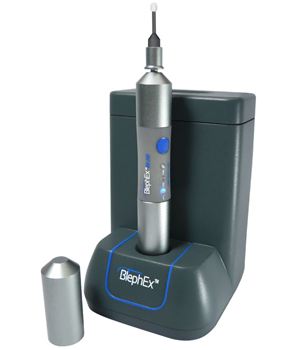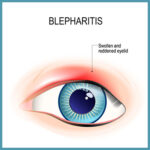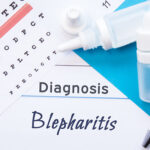Dry eye, blepharitis…it can all sound like another language if you’re not familiar with them. But you’ll know the symptoms if you have them: itchy eyes, irritated eyelids, and discomfort.
If you’ve been diagnosed with blepharitis, keep reading to learn more about BlephEx!
 What is Blepharitis?
What is Blepharitis?
Although blepharitis and dry eye can be connected and may occur at the same time, they are different. Blepharitis is a condition that causes eyelid inflammation.
If you have blepharitis, you suffer from painful, red eyelids and crusty eyelashes. Not only is it not fun to look at, but blepharitis causes significant discomfort as well. If you have the condition, you may wonder how you got it. Common causes of blepharitis include:
● dry eye
● Demodex eyelash mites (parasites)
● Meibomian gland dysfunction or MGD
● a bacterial eyelid infection
You’ll notice that one of the causes of blepharitis is dry eye. That’s not to say that if you have blepharitis, you’ll also have dry eye or vice versa. But there is often a correlation between having blepharitis and dry eye.
When your eyes produce tears, they have three components: oil, water, and mucus. To keep your eyes hydrated and lubricated, your tears need to have all three components in them.
Many people with dry eye have it because they have meibomian gland dysfunction or MGD. If you have MGD, it means that your meibomian glands have become blocked up.
If this happens, your eyes stop producing the proper amount of oil in your tears. When the tears don’t have enough oil, they evaporate from your eyes too fast. It’s this evaporation that can lead to MGD, blepharitis, or dry eye.
 Is it Dry Eye or Blepharitis?
Is it Dry Eye or Blepharitis?
If dry eye and blepharitis can appear at the same time, how are you supposed to tell them apart? It doesn’t help that some of the symptoms of dry eye and blepharitis can overlap either.
The only person who can tell if you have blepharitis or dry eye is your eye doctor. But generally, the biggest difference between these conditions is where symptoms are occurring.
With blepharitis, there’s specifically eyelid inflammation and crusty eyelashes. With dry eye, symptoms are usually dry eyes, redness, irritation, or a feeling of grit. If you think you might have blepharitis or dry eye, see your eye doctor.
Leaving either of these conditions untreated only results in more irritation. If you wait too long, you could do some serious damage to the health of your eyes! You could be looking at vision loss, corneal issues, and more!
 Diagnosing Blepharitis
Diagnosing Blepharitis
Maybe you’re reading the list of symptoms of blepharitis and you’re convinced you have it. Sorry, but the only way to know if you have blepharitis is to get tested for it by your eye doctor.
Since some of the common symptoms of blepharitis can be seen, your eye doctor will examine your eyes. Your eyelids will also get examined. They may use a magnifying instrument to help them see as well.
Your eye doctor may check the quality and quantity of the tears that you produce. This can help them determine if you have any abnormalities with your tears, or if you have dry eye.
Can you treat Blepharitis?
We understand the differences between blepharitis and dry eye, but what about treatment? After all, living with the frustrating symptoms of blepharitis gets old, and fast!
If patients have blepharitis, the first treatment option is usually warm compresses. This helps break up any crust or debris on the eyelid. They also loosen up blocked meibomian glands that aren’t producing enough oil.
Warm compresses are typically paired with daily instructions to cleanse your eyes. Your eye doctor will either prescribe or suggest solution, cleansing foam, sprays, or wipes you can use to keep your eyes clean. You will then gently cleanse each lid with a clean cloth for each eye.
Your eye doctor may also prescribe antibiotics to kill bacteria on your eyelids. Other medications they may prescribe include anti-inflammatory steroid eye drops or ointments.
If your blepharitis is due to an underlying condition, the condition may be treated. Common underlying conditions include:
● seborrheic dermatitis
● rosacea
● dandruff
What if my blepharitis hasn’t responded to other treatments?
At Fichte Endl & Elmer Eyecare, we have a solution! For patients with blepharitis that hasn’t responded well to treatments, we offer BlephEx.
BlephEx is a revolutionary procedure performed in-office by Dr. Shenkle. BlephEx thoroughly cleans your eyelids gently by using a medical grade micro-sponge. This micro-sponge spins at the edges of your eyelashes and eyelids.
is a revolutionary procedure performed in-office by Dr. Shenkle. BlephEx thoroughly cleans your eyelids gently by using a medical grade micro-sponge. This micro-sponge spins at the edges of your eyelashes and eyelids.
The edges are the worst spots where debris and crusts build up from blepharitis. Before the procedure even starts, Dr. Shenkle will put numbing drops in your eyes.
There is no pain associated with BlephEx and it’s over after a few minutes. To see the best possible results from BlephEx, you’ll need several visits.
Like any eye condition, it takes time for your eyes to start recovering from the symptoms of blepharitis. You may need to repeat the procedure every 4-6 months. Talk to your eye doctor about how frequently you should undergo BlephEx.
Who is BlephEx right for?
Although BlephEx is a blepharitis treatment, other patients may be right for it. BlephEx can treat the following symptoms:
● crustiness
● dry eyes
● itchy eyes
● redness or inflammation
● constant eye rubbing
● tearing eyes
● foreign body sensation in the eye
For patients suffering from the symptoms of dry eye, BlephEx can be life-changing! The same is true for patients who wear contact lenses. When wearing contacts, the eyes get less oxygen.
For many patients, this can result in symptoms or dry eye or inflamed tear ducts. BlephEx can help with these symptoms and more!
Wondering if BlephEx could be right for you? Schedule an appointment at Fichte Endl & Elmer Eyecare at our Niagara Falls office!


 What is Blepharitis?
What is Blepharitis? Is it Dry Eye or Blepharitis?
Is it Dry Eye or Blepharitis? Diagnosing Blepharitis
Diagnosing Blepharitis